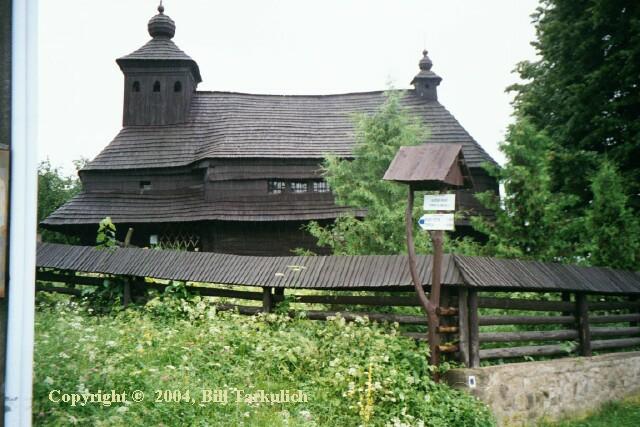| Slovakia Genealogy Research Strategies | ||||||
| Home | Strategy | Place Names | Churches | Census | History | Culture |
| TOOLBOX | Contents | Settlements | Maps | FHL Resources | Military | Correspondence |
| Library | Search | Dukla Pass | ||||
Uličské Krivé (Gorbeszeg)

Church
of St. Michael Archangel (1718)
|
Village Information |
Village Links |
Regional |
|
Surnames |
|
Online Book: Below Snina Rock (1964) |
|
Road Map |
Online Book: History of Ulic, Slovakia (1996) (PDF) |
|
|
Reference in Wooden Church book from Folk Museum of Ukrainian Culture at Svidnik |
History of the Ulic Valley, 2002 (rewrite of the 1996 version) |
|
More Wooden Church Photos |
1914 Zemplin County Map (714KB) |
Greek Catholic Church: Originally St. Michael Archangel 1718 (L, NKP). Affiliated Church Ruský Potok - St. Michael Archangel 1740 (L, NKP), Administered by Ulic church. Church is no longer in operation (controlled by Orthodox)
Highlights
| First Mentioned | 1451 |
| 2001 Population | 69 Rusyn, 15 Ukrainian, 289 Other 66 Orthodox, 213 Greek Catholic, 94 Other |
| 2001 Population | 162 |
| 1921 Pop. Peak | 519 |
| 1914 Population | 405 9 Magyar, 35 German, 355 Ruthenian; 5 Roman Catholic, 362 Greek Catholic, 38 Jew |
|
Total Area |
1,290 hectare |
| Names | 1451 Hvlydch, Hulicz, Hulitsch, 1773 Uluež, 1808 Uliča |
Surnames
Photos
History, Vasil Fedič, 2003
The village was established by Walachian law, as property of the Humenne estate during the 16th – 17th century. In the 16th century the village was not taxed. In 1715 mention was made of 12 dwellings, of which 6 were deserted. In 1720 a village mill is mentioned. The mill was discontinued, since starting in 1795 the mill is no longer mentioned. In later years grinding mills and seasonal mills in other communities were established. In 1787 the village and surroundings were owned by Mariassz, in the 19th century Dessewffz during which an interim manor-house was constructed. In the 19th century large land pieces were owned by the Mokcaj and Rick families. Later they were owned by Maximilian Felledi.
The villagers worked in the forests and in wood production. Typical of this region was terraced style cultivation on high mountain ledges. In 1939-1944 was village was annexed by Hungary.
Military operations left their mark. During the advancing front, which remained here for five weeks, the retreating forces burned nearly 20 homes. There were military as well as civilian casualties. The Ninth Russian combat division fought with the 1st Czechoslovakia military force and under four ordinary Red armies. The village was liberated on 25 October 1944.
In the post-war period registers, the village logged emigration of residents for work, primarily to the Czech lands. Shortly after the war, 30 residents of Rusky Potok moved there permanently.
1478 Kirwa, 1773 Ulicz Kriva. Mentioned for the first time in 1478, it Belonged to Humenné town, to Izbugyai counts and in the XIX century to nobles Kiss (Kissov). During the History, its inhabitants were occupied as woodmen. Source: Roberto Cannoni, Italy
Landmarks
-
In the village is located a national culture monument – the wooden church of St. Michael Archangel. It was built in 1740. It is a three-space structure with a polygonal sacristy, square center and a babynet (Women’s room), over which is a tower was built into the roof.
-
The main altar with iconostasis is baroque from first half of the 18th century.
Surnames
BUCHLAK, COGAN, KOCSAN, KOVAL, MOCHNAC, ROHUTANICZ, KORKABECZ, KERISLER, PETELY, SUKALY.
Photo Credit: Bill Tarkulich, Mick Sura, 2001
Links to off-site webs will open in a new window. Please disable your pop-up stopper.
Last Update: 15 November 2020 Copyright © 2003-2021, Bill Tarkulich






